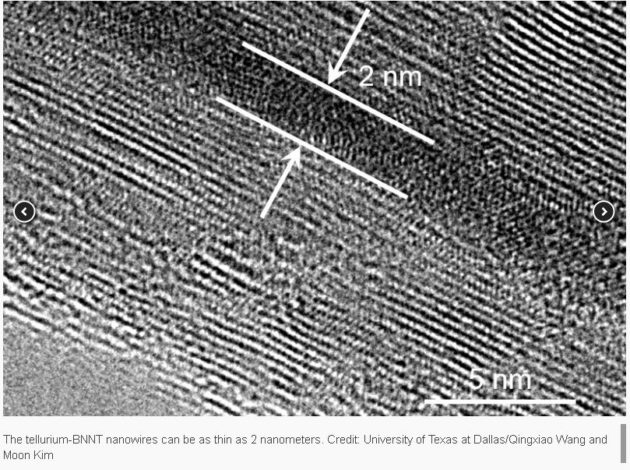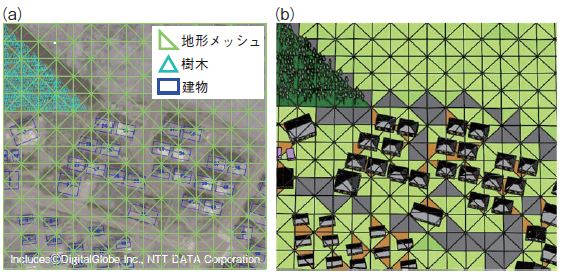(Atomic Chains in Nanotubes Push the Electronics Frontier)
2020/2/10 アメリカ合衆国・ミシガン工科大学


・ ミシガン工科大学がパデュー大学、ワシントン大学およびテキサス大学ダラス校と共同で、カーボンナノチューブ(CNTs)や窒化ホウ素ナノチューブ(BNNTs)に内包されたテルルナノワイヤの特性の発見とそのポテンシャルについて報告。
・ ウェアラブル技術、電子テキスタイルやオブジェクト等の表面に貼り付ける極薄デバイスの開発に向け、ナノ材料の原子構造が注目されている。身体の動きに沿って折曲がりながら強度を維持して多様な温度を耐久し、スマートフォン等のソフトウェアの作動に充分な電力を供給する材料が必要となる。
・ ミシガン工科大学チームは、これまでにナノチューブとナノ粒子の量子力学的な挙動の特異性や有望性を発見し、BNNTs 表面に金と鉄のナノ粒子を添加した絶縁性ナノチューブをエレクトロニクスで初めて使用している。このような金属とナノチューブから成る構造は、シリコントランジスタの壁を電子が通り抜ける、量子トンネル効果を高めるもの。
・ BNNTsは、中空のチューブ状で絶縁性が高く極めてフレキシブル。そのため、優れた電気特性が期待できるテルルのような他の材料との組み合わせに最適な材料。BNNTs の中空にテルルの原子鎖を通すと、極微細なナノワイヤとして非常に高い通電容量が得られる。
・ BNNTs の絶縁性により、内部のテルル原子鎖からの信号が分離できるようになったため、その量子的な挙動の検証が可能に。実際に測定可能なこのような原子鎖を作製したのは今回が初めて。次の課題は BNNTs をさらに微細化すること。
・ テルルナノワイヤは、バルクのそれとは異なる物理特性と電気特性を示すため、世界最小のトランジスタの構築が期待できる。透過型電子顕微鏡による調査では、テルルナノワイヤの一次元の原子鎖が曲がりくねった状態であることを確認(シリコン原子では直線状)。
・ テルル-BNNTs ナノワイヤによる電界効果トランジスタ(FET)は、幅が僅か 2nm(現行のシリコントランジスタは 10~20nm)。ほとんどの半導体ナノワイヤを超える、1.5×108A cm-2 の電流密度を達成。
・ 同ナノワイヤはまた、光と圧力による制御が可能。次世代エレクトロニクスで有用となる。カーボンナノチューブ(CNTs)でテルルナノワイヤの内包を試みたが、炭素の導電的・半導体的性質から測定できなかった。
・ 同ナノワイヤをウェアラブルや電子テキスタイルで実用化するには、テルル原子鎖の性質をさらに深く把握する必要がある。
URL: https://www.mtu.edu/news/stories/2020/february/atomic-chains-in-nanotubes-push-theelectronics-frontier.html
(関連情報)
Nature Electronics 掲載論文(アブストラクトのみ:全文は有料)
Raman response and transport properties of tellurium atomic chains encapsulated in nanotubes
URL: https://www.nature.com/articles/s41928-020-0365-4
<NEDO海外技術情報より>
Abstract
Tellurium can form nanowires of helical atomic chains. With their unique one-dimensional van der Waals structure, these nanowires are expected to show physical and electronic properties that are remarkably different from those of bulk tellurium. Here, we show that few-chain and single-chain van der Waals tellurium nanowires can be isolated using carbon nanotube and boron nitride nanotube encapsulation. With this approach, the number of atomic chains can be controlled by the inner diameter of the nanotube. The Raman response of the structures suggests that the interaction between a single-atomic tellurium chain and a carbon nanotube is weak, and that the inter-chain interaction becomes stronger as the number of chains increases. Compared with bare tellurium nanowires on SiO2, nanowires encapsulated in boron nitride nanotubes exhibit a dramatically enhanced current-carrying capacity, with a current density of 1.5 × 108 A cm−2 that exceeds that of most semiconducting nanowires. We also use our tellurium nanowires encapsulated in boron nitride nanotubes to create field-effect transistors with a diameter of only 2 nm.



